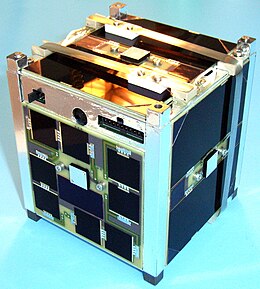cosmos.wikisort.org - Spacecraft
BeeSat-1 or Berlin Experimental and Educational Satellite 1, is a German satellite operated by the Technical University of Berlin. The spacecraft is a single unit CubeSat, which was designed to test systems intended for use on future spacecraft, including a new design of reaction wheel.[2][3] It has also been used for amateur radio, and is equipped with a small camera.[4]
 BeeSat-1 before launch | |
| Mission type | Technology |
|---|---|
| Operator | TUB |
| COSPAR ID | 2009-051C |
| SATCAT no. | 35933 |
| Website | www |
| Mission duration | 12 months (planned) 15+ months (achieved) |
| Spacecraft properties | |
| Spacecraft type | 1U CubeSat |
| Launch mass | 1 kilogram (2.2 lb) |
| Start of mission | |
| Launch date | 23 September 2009, 06:21 UTC |
| Rocket | PSLV-CA C14 |
| Launch site | Satish Dhawan FLP |
| Contractor | ISRO |
| Orbital parameters | |
| Reference system | Geocentric |
| Regime | Sun-synchronous |
| Perigee altitude | 713 kilometres (443 mi) |
| Apogee altitude | 723 kilometres (449 mi) |
| Inclination | 98.36 degrees |
| Period | 99.01 minutes |
| Epoch | 21 January 2014, 05:49:02 UTC[1] |
BeeSat-1 was launched by a Polar Satellite Launch Vehicle, serial number C14, flying in the Core Alone, or PSLV-CA, configuration.[5] The launch took place from the First Launch Pad at the Satish Dhawan Space Centre, at 06:21 UTC on 23 September 2009.[6] BeeSat-1 was a secondary payload aboard the rocket, which deployed the Oceansat-2 satellite. Five other secondary payloads were flown aboard the rocket; SwissCube-1, UWE-2, ITU-pSat1, Rubin 9.1 and Rubin 9.2.[7][8]
BeeSat-1 is operating in a sun synchronous orbit with an apogee of 723 kilometres (449 mi), a perigee of 714 kilometres (444 mi) and 98.4 degrees of inclination to the equator. It has an orbital period of 99.16 minutes.[9] BeeSat-1 was designed to operate for at least twelve months,[2] and as of January 2011[update] it is still operational.[4]
See also
- 2009 in spaceflight
- List of CubeSats
References
- "BEESAT Satellite details 2009-051C NORAD 35933". N2YO. 21 January 2014. Retrieved 21 January 2014.
- "BEESAT-1". TUB. 25 May 2010. Archived from the original on 18 February 2011. Retrieved 6 January 2011.
- "BeeSat-1 (Berlin Experimental Educational Satellite-1)". eoPortal Directory. eoPortal. Archived from the original on 26 July 2011. Retrieved 6 January 2011.
- "BEESAT". AMSAT. Archived from the original on 3 March 2011. Retrieved 6 January 2011.
- Wade, Mark. "PSLV CA". Encyclopedia Astronautica. Archived from the original on 11 October 2011. Retrieved 6 January 2011.
- McDowell, Jonathan. "Launch Log". Jonathan's Space Page. Retrieved 6 January 2011.
- Krebs, Gunter. "BeeSat". Gunter's Space Page. Retrieved 6 January 2011.
- Krebs, Gunter. "Rubin 9". Gunter's Space Page. Retrieved 6 January 2011.
- McDowell, Jonathan. "Satellite Catalog". Jonathan's Space Page. Retrieved 6 January 2011.
На других языках
[de] Beesat
Beesat (auch Tubsat 8) war ein Picosatellitenprojekt an der Technischen Universität Berlin. Beesat erfüllt den Cubesat-Standard und hat somit äußere Abmessungen von 10 × 10 × 10 cm³ und eine Gesamtmasse von weniger als 1 kg. Hauptziel des Projektes war die Weltraumverifizierung neu entwickelter, miniaturisierter Reaktionsräder und weiterer Technologien für Picosatelliten. So sollten Anwendungsfelder eröffnet und die speziellen Vorteile stark miniaturisierter Satelliten weiter nutzbar gemacht werden. Es folgte eine Serie weiterer Cubesats, beginnend mit Beesat-2 und Beesat-3.- [en] BeeSat-1
Другой контент может иметь иную лицензию. Перед использованием материалов сайта WikiSort.org внимательно изучите правила лицензирования конкретных элементов наполнения сайта.
WikiSort.org - проект по пересортировке и дополнению контента Википедии